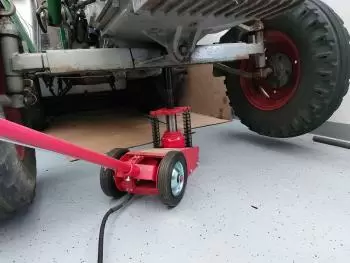
Have you ever needed to lift a car to change a tire or repair something under the vehicle? In this case, you must have heard about hydraulic jacks. This essential tool in any auto shop can also be handy around the home for maintenance and repair tasks.
The hydraulic jack works thanks to Pascal's principle to lift high loads, making it an example of fluid mechanics.
What is a hydraulic jack?
A hydraulic jack is a mechanical tool used to lift heavy objects. It consists of a piston cylinder with valves and hoses connecting to a hydraulic oil source. Oil is used as an incompressible working fluid, which transmits the force of the piston through the hoses to the object to be lifted.
Uses and application of hydraulic jacks
The hydraulic jack is a tool used to lift heavy objects or apply force on them. The main advantage of the hydraulic jack is its great strength and high load capacity, allowing it to lift things much heavier than human muscle power.
Another benefit is that the hydraulic jack can apply force evenly, making it ideal for jobs requiring precise lifting or controlled movement.
How does a hydraulic jack work?
Hydraulic jacks are a type of lifting device used to lift heavy objects. The operating principle is based on Pascal's law and the law of the lever.

Pascal's law applies when passing hydraulic fluid from small to large hydraulic cylinders. According to Pascal's law, by transmitting the pressure of the liquid to all points of a larger area, a force much greater than the initial one is obtained. As oil enters the large cylinder, the piston rises; thus, it is possible to lift weighty loads.
In order to keep the fluid flowing in the right direction, these devices include check valves. The bearing pad is the contact point with the lift point. Depending on the type of load, they can include a lift pad to help lift to protect the load and get more stability.
Finally, they have a release valve to low the pressure and, accordingly, the load.
Types of hydraulic jacks
Hydraulic jacks fall into three categories: garage, industrial, and portable jacks. Each has its own characteristics and benefits:
-
Garage jacks are the most common and are used to lift heavy vehicles such as cars or trucks. Their main advantage is that they are compact and easy to store, and their price is affordable.
-
Industrial jacks are more robust and durable than domestic models but are also more expensive.
-
Portable jacks are ideal for taking in the car or motorcycle since they are light and small. They tend to be less powerful but are very versatile.
Types of hydraulic car jacks
There are several types of hydraulic car jacks with different ranges of vertical lifts:
Scissor jacks
Scissor jacks use their mechanical multiplication ability to allow vertical lifting of a vehicle (specifically to replace a flat tire) using only the manual strength of one person.
Trolley jacks (or floor jacks)
Floor jacks are the most used type of hydraulic car jack used in mechanical garages. Trolley jacks offer perfect mobility to be manipulated below any height. Fixed or swivel, the wheels allow for precise positioning under vehicles (cars, SUVs, 4x4s, utility vehicles) before lifting.
The maximum lifting capacity can vary between 1.3 tons and 10 tons depending on the selected model. Hydraulic trolley jacks are characterized by a compact size to simplify storage after use.
Some jacks are equipped with handles to make raising and lowering vehicles easier.
Jacks with extra low profiles allow you to work on vehicles with a low height.
Balloon Jacks
Air Balloon Jacks make it easy, effortless, and fast to lift light-duty vehicles, SUVs, and SUVs up to 2 tons.
To operate, these jacks must be connected to a compressed air network.
These jacks have a large travel capacity (2 to 3 cushions) and are available in several short or long-handle versions. They are also equipped with wheels to facilitate their placement under the vehicle.
Oleo-pneumatic jacks
The oleo-pneumatic jacks can lift from 10 to 80 tons. They are used to lift from small trucks to construction or mining machinery, including buses and heavy vehicles.
Lifting and lowering operations are performed with compressed air to lift heavy loads effortlessly. A compressed air network or compressor must be available to use this type of jack.
For easy handling, the hydropneumatic jacks have a long handle with lowering and raising control.
Bottle Jacks
Handy and usually small in size, the bottle jack or hydraulic piston jack makes it easy to lift heavy objects.
Bottle jacks are solid and stable thanks to welded steel construction. They can work both horizontally and vertically.
They are ideally suited for car workshops, heavy vehicles, or other agricultural or construction machinery.
Roadcraft jacks are robust and perfectly suitable for use in workshops, heavy vehicles, and other automobiles (buses, agricultural machinery, construction machinery, etc.)
Alternatives to hydraulic jacks
The main alternatives to hydraulic jacks are basically two:
-
First, the pneumatic jack is a tool used to lift heavy loads through a lever. This system multiplies the force exerted on the lever aided by a threaded piece, spindle, and compressed air.
-
The screw jack operational system is based on a threaded part and a spindle. As a result, the loads that these mechanical jacks lift are smaller.


